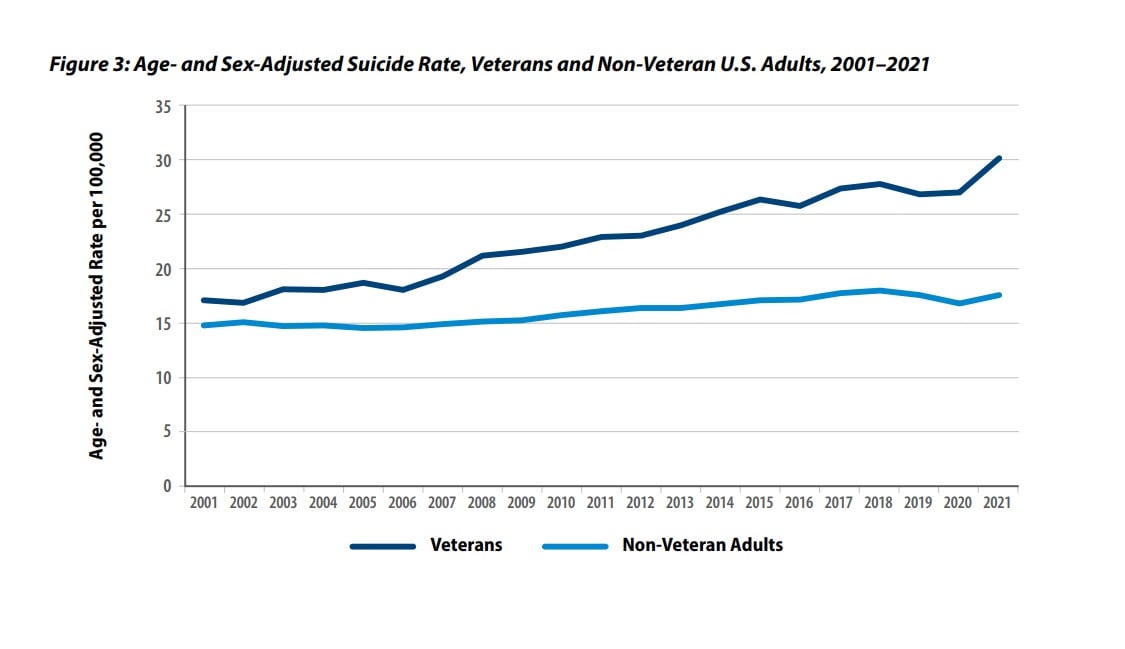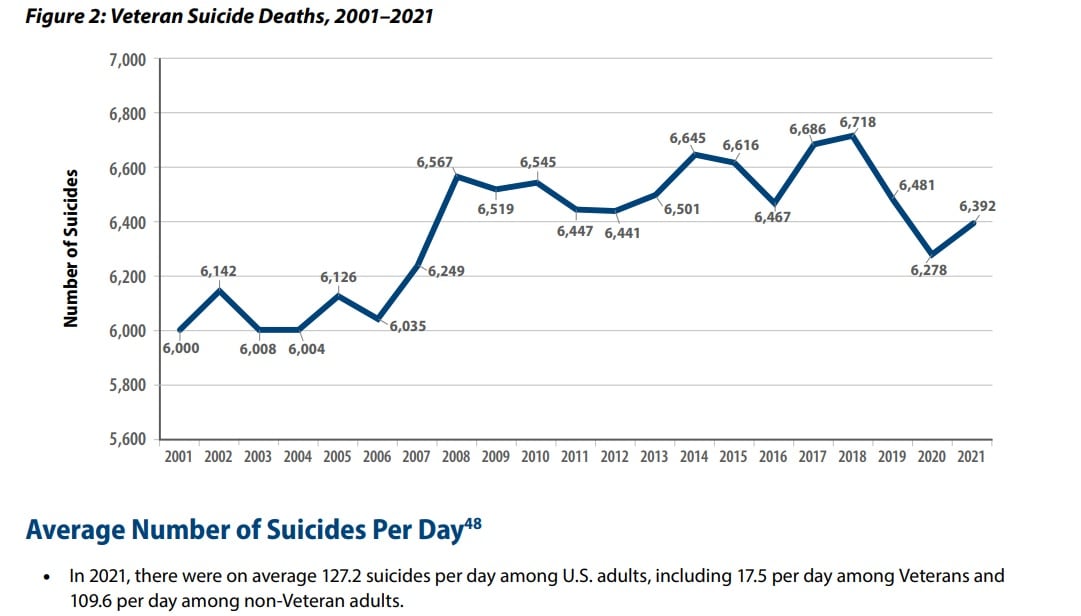The suicide rate among veterans rose slightly in 2021 as federal officials struggled to make more progress in their outreach and emergency response efforts designed to curb self-harm.
According to estimates released by the Department of Veterans Affairs on Thursday, suicides among veterans were up 1.8% from 2020 to 2021, the most recent year for which state death data is available. The totals had dropped each of the two years before the 2021 reversal.
An estimated 17.5 veterans died by suicide every day in 2021. That’s the second lowest rate since 2007 but still translates into nearly 6,400 preventable veteran deaths that year.
Officials said stress from the coronavirus pandemic may be partially to blame for the increase, noting that suicide rates across America rose from 2020 to 2021. Researchers also found higher levels of gun ownership among all Americans in 2021, a complicating factor since most veteran suicide deaths involve firearms.
RELATED

But they emphasized that suicidal thoughts and actions are rarely the result of a single factor, and addressing the problem will require a complex array of support services and public education efforts.
More than 71,000 veterans died as a result of suicide from 2011 to 2021. That’s 10 times the total number of troops killed in the wars in Iraq and Afghanistan over 20 years.
“We will do everything in our power to learn from this report and use its findings to help us save lives,” VA Under Secretary for Health Dr. Shereef Elnahal said in a statement accompanying the data release. “It will take all of us working together to end veteran suicide, and we will not rest until that goal becomes a reality.”
VA researchers found that veterans are nearly twice as likely as their civilian peers to die by suicide, a persistent trend in recent years that has led to billions of dollars in outreach and intervention programs over the last 20 years. But efforts to bring down those suicide totals have been limited and inconsistent.
Fewer than 40% of the suicide deaths among veterans involved individuals who had recently used VA health services. Department leaders said that points to the need for wider community involvement in helping veterans in times of crisis.
“VA health care is not the only part of the answer,” Elnahal said.
Researchers found lower rates of suicide among veterans aged 75 years and older and those 34 years and younger, both encouraging signs. But they also reported higher rates among women veterans, homeless veterans, American Indian and Alaska native veterans, and numerous other subsets of the veteran population.
In the last year, VA officials have launched several initiatives to help provide additional support services to veterans experiencing mental health emergencies. That includes offering no-cost suicide prevention care at any health care facility — VA managed or unaffiliated with the department — since January, an effort officials said has already helped 33,000 veterans.

The department has also increased campaigns focused on the safe storage of firearms, which were used in 72% of veteran suicides in 2021. By contrast, 54% of all U.S. suicide deaths in 2021 involved guns. These efforts have included distribution of more than 400,000 gun locks and lethal means safety training to about 2,300 community health care providers.
But Veterans Affairs Secretary Denis McDonough, in a statement accompanying the report, acknowledged that more needs to be done on the issue.
“One veteran suicide will always be one too many, and we at VA will use every tool at our disposal to prevent these tragedies and save veterans’ lives,” he said.
Including suicide deaths among active-duty troops, National Guard personnel and military reserve members raises the suicide rate for the military and veterans community to about 20 individuals every day.
Some veterans advocates have argued that figure is likely much higher, because some drug overdose deaths and other accidental fatalities are not included in official federal calculations of suicides.
House Veterans’ Affairs Committee Chairman Mike Bost, R-Ill., called the report’s findings worrisome.
“Too many of our veterans are still suffering in silence,” he said in a statement. “While Congress has made an incredible investment in VA’s suicide prevention efforts over the past decade … this increase is still troubling.”
Bill Clark, national commander at AMVETS, called for large-scale changes in VA’s approach to suicide prevention in light of the lack of progress in addressing the problem over the last 20 years.
“We cannot afford to lose more lives while navigating bureaucratic processes,” he said. “We need swift, decisive action that puts the well-being of our veterans at the forefront.”
Veterans in need of emergency counseling can reach the Veterans Crisis Line by dialing 988 and selecting option 1 after connecting to reach a VA staffer. In addition, veterans, troops or their family members can also text 838255 for help, or visit VeteransCrisisLine.net for assistance.
Leo covers Congress, Veterans Affairs and the White House for Military Times. He has covered Washington, D.C. since 2004, focusing on military personnel and veterans policies. His work has earned numerous honors, including a 2009 Polk award, a 2010 National Headliner Award, the IAVA Leadership in Journalism award and the VFW News Media award.




